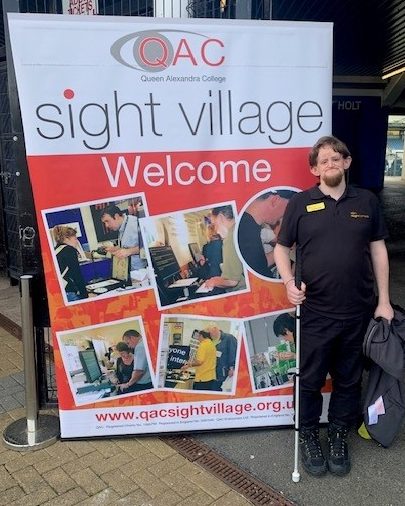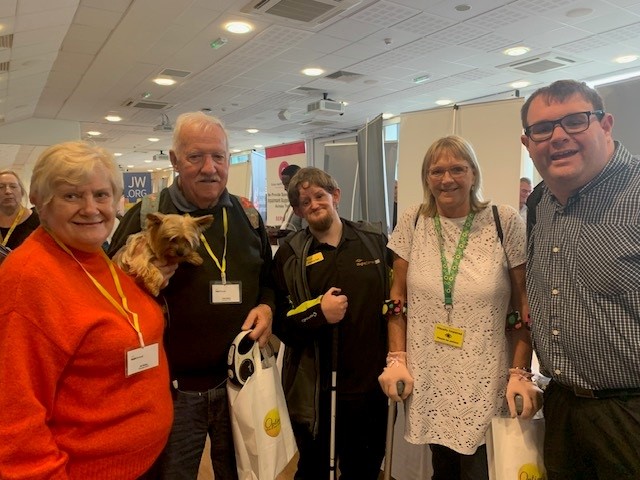QAC Sight Village South-West 2023
The Queen Alexandra College (QAC) Sight Village returned to Exeter last month for the 2023 South West edition of the massive exhibition event and iSightCornwall’s Dom Hall went along for the experience.
Dom is iSightCornwall’s Assistive Technology Advisor and, being visually impaired himself, he has a keen interest in improvements and advancements in technology designed to help people who are blind and visually impaired.

Described as “The UK’s leading exhibition for blind and partially sighted people and for those experiencing sight problems”, Sight Village welcomes thousands of people through its doors every year and waiting for them are hundreds of companies and organisations waiting to showcase their products.
Dom’s Thoughts on Sight Village 2023
Dom said: “Sight Village is a fantastic experience; I very much encourage anyone who has sight loss to try and get to at least one of their events as it can really showcase how quickly technology is advancing and how much can already be done to help you live your day-to-day life whilst maintaining your independence.
“I do feel like this year’s event was smaller than previous installments of Sight Village but there were still so many exhibitors with familiar names being joined by new, up-and-coming companies and organisations.”
Who was there?
This year’s Sight Village was sponsored by Sight and Sound Technology as well as Deafblind UK with both having a large presence.
Those who have attended an iSightCornwall event or had an Assistive Technology appointment would have recognized some of the names at the event such as Dolphin, HumanWare, Optelec UK/Enhanced Vision, Optima, OrCam UK, Synapptic and VisionAid who all brought a range of technologies to demonstrate.

Dom said: “I continue to be impressed by the range of electronic magnifiers, text-to-speech devices and software designed to help people use computers or phones without sight. There have been some brilliant advancements over the last few years, and it was really good to be able to chat to representatives from each company to hear what they have been up to.
“I got to try HumanWare’s Explore 12 electronic magnifier, Optelec’s Compact 7 and Optima’s Lunar Range which were all really interesting with new features from their earlier counterparts. I’m looking forward to doing a separate blog on those devices soon.
“What really caught my attention this year were the advancements being made on the mobility side of technology. From smart canes with GPS and audio instructions to devices you can wear which can help you orient yourself and avoid obstacles.
Three Things You Might Not Have Seen Before
Dom: It was hard to pick just three but sticking to the theme of mobility, in no particular order, my three picks for new tech to check out are the following:
Biped

Biped is a smart harness, worn on the shoulders, which helps the user detect obstacles and get GPS instructions. It uses AI to and self-driving car software from the Honda Research Institute.
Dom says: I was really intrigued by the Biped device, it’s quite light and sits on your shoulders. The cameras and AI mean it can let you know about incoming obstacles, people and even traffic. It will then play short beeps via Bluetooth headphones to alert you of danger. The company are working on bringing GPS instructions to the device which will provide turn-by-turn instructions such as ‘in 20 meters, turn left’.
“It was really fun to be able to see one of these in person at the Sight Village and I think this is a great product to keep up to date with as the team are set to make even more improvements and continue to develop the Biped’s features.”
To learn more about the Biped and to keep up to date with the development, click here.
StellarTrek
Created by HumanWare, who are behind the popular Explore range of electronic magnifiers, the StellarTrek is described as a ‘digital orientation and mobility assistant’. It looks like a remote control which is about the size of your hand and uses GPS, cameras, and AI to locate and recognize street addresses, doors and entrances to guide you to your destination.
Dom said: “If anyone with sight loss has ever tried to use an existing sat nav application, you probably know how frustrating it is to try and follow the guidance with audio commands alone.
Especially when the application gets you to within 50 yards of your destination before leaving you to find your own way.
“The StellarTrek is designed to be better, using voice guidance to get you to the door of your destination. It can also use the built-in cameras to read barcodes, recognize colours and scan text to read aloud. It is really taking technology which is already well-proven to help people with sight loss, such as text-to-speech, and combining it with new AI features to help create new devices.”
To find out more about the StellarTrek, click here.
WeWALK Cane

The WeWALK Cane combines the familiar white cane with smart technology, allowing it to navigate the user, check bus and train timetables, and detect above-ground obstacles with ultrasound whilst still retaining the standard white cane’s ground feedback.
Dom says: “Anyone who uses a cane already knows how handy they can be but imagine if your cane could also give you directions, find the nearest bus stop or alert you to obstacles that you’re approaching. That’s the idea of the WeWalk Cane. I particularly like the fact that when the WeWalk navigates you, it can give you directions as clock positions so, for example, instead of saying turn right, it can say turn to 2 o’clock to give you more precise and easier to follow commands.
“The WeWALK does use an integrated app on your smartphone but the cane itself actually has a built-in touchpad so you can leave your phone in your bag or pocket and control the WeWalk’s features via the touchpad.”
To find out more about the WeWALK Cane, click here.



